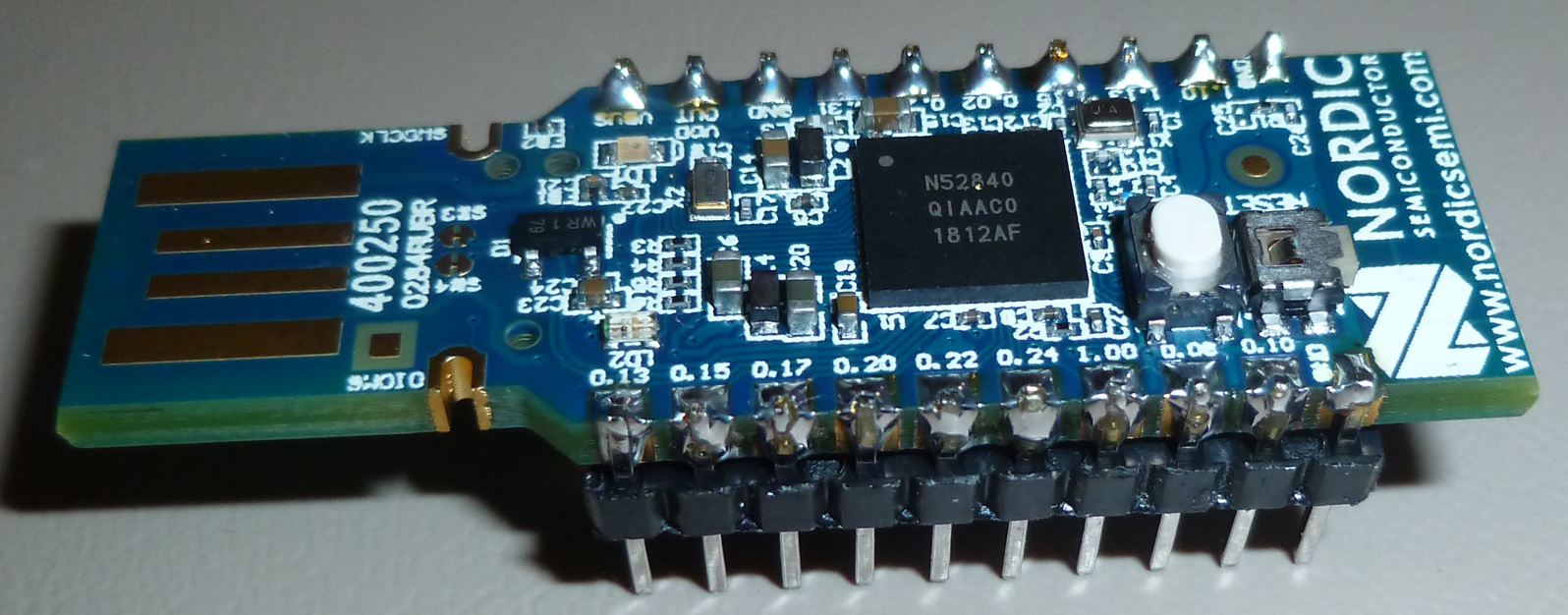Everything nRF52840
-
@NeverDie thanks for the hints/offer:
I have connected to the nRF52840 DK via the P20 connector
Here is the wiring setupVDD---> VTG of P20 in DK board
SWDIO--> SWDIO of external board
SWDCLK-->SWDCLK of external Baord
GND DETECT--> GND of external Board
GND--> GND of external baord. -
@neverdie I admit that I also powered the module via the DK because it takes less than 20mA. I used this connection description:
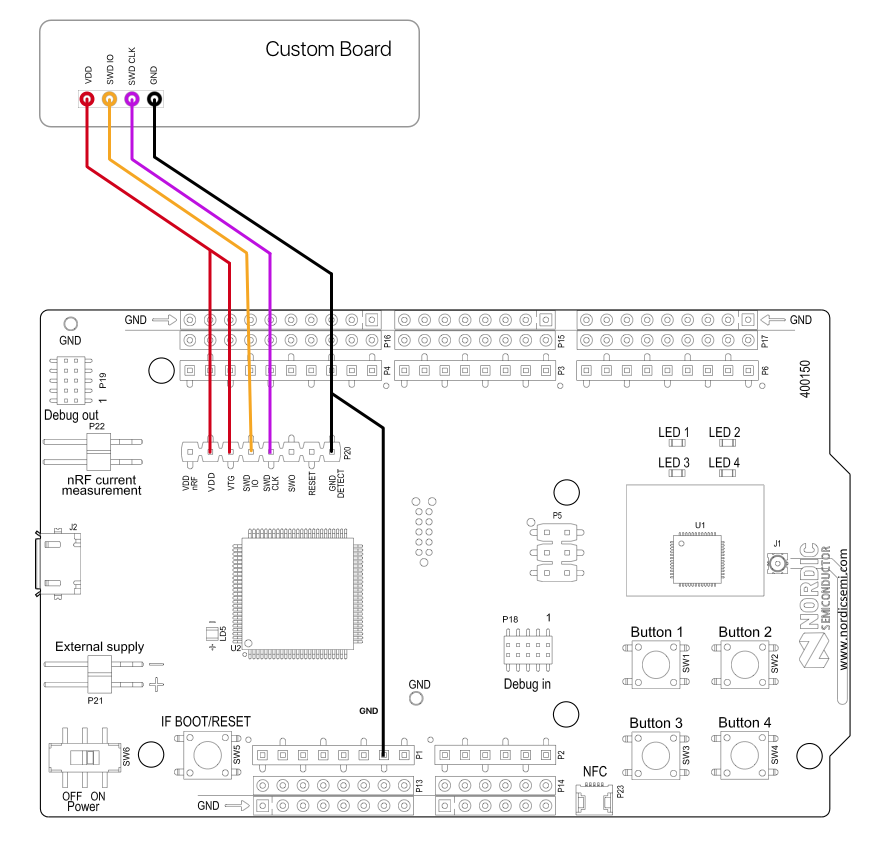
But I'll try to use a complete an external PS next time and see if it makes a difference.@heinzv Nice picture. Hmmmm..... Seems like your wiring should work. Maybe try VDDnRF instead of VDD? I'm not sure what the difference is, but I think that may have been what I used most recently.
Are you dragging the hex file to the virtual drive on the PC to upload it to the target? If so, what exactly happens when you do? It should be as simple as that.
I'm using Windows 10. What about you? Not sure if the version of Windows has anything to do with it.
It appears that you are using the nRF52832 DK. Correct? What exactly is the target that you are trying to upload to?
One way or another we'll get this thing solved for you. :wink:
-
@NeverDie thanks, appreciate your help as you are far ahead.
Here is my update: I have build 4 nRF52832 boards with the E73 EBYTE modules and two nRF52840 board with the tiny holyiot modules (see picts below).
It seems that by using the wiring shown in my last post, I can flash the 840 boards. I'll also try again one of the working 832 boards later (I'm in business trip the next few days).
But I have a couple of questions to you:
1.) I don't know how to identify which MCU will be flashed. I only see the J-Link adapter in Segger or the board with the Segger Serial in nRFgo Studio. How can I know, that I'm not flashing the DK onboard MCU? Where is this shown, indicated where the flashing will go? That is strange to me. Another example is my sel build Black Magic Probe: It shows which devices are connected to it and you can select one (if multiple are shown in a select - select target 1,2 ...)
2.) How can I make use of any bootloader (DFU, Serial, USB, OTA, ANT etc.) so that flashing with the DK is not always required? I have not found a good way so far to flash any useful bootloader (I have tried some of the examples). The onyl one which creates a serial devices is the example for the PCA100059 (the USB dongle) which shows a serial device: nRF52 SDFU USB (COM75). HOw to make use of that (I have tried all of the offered programmer als oin Arduino IDE but could not upload/flash my blink sketch)
3.) How to you flash the USB dongle beside using the nRFconnect which requires the compiled image?
Are you also soldering the SWD pins and use them with the Segger and the DK?
4.) When I flashed your micropython (or circuitpython?) for the 840 (my board). How to I connect and use it? My 840 boards have it's own USB port (see topic 2, which shows the nRF52 SDFU port when I flash the one bootloader). When I flash the MP, the ports are gone (how to connect via USB, Serial, Terminal etc.)?I've also tried a couple of other things like a DFU bootloader with a S140 softdevice (as it was recommended by Nordic) but was not sucessful to combine them (the S140 was flashed, but then?)
I have many more questions but I hope we can sort out some of the 1-4. I hope I have described them so that you can follow my thoughts and questions :-)

nrf52840 on DK
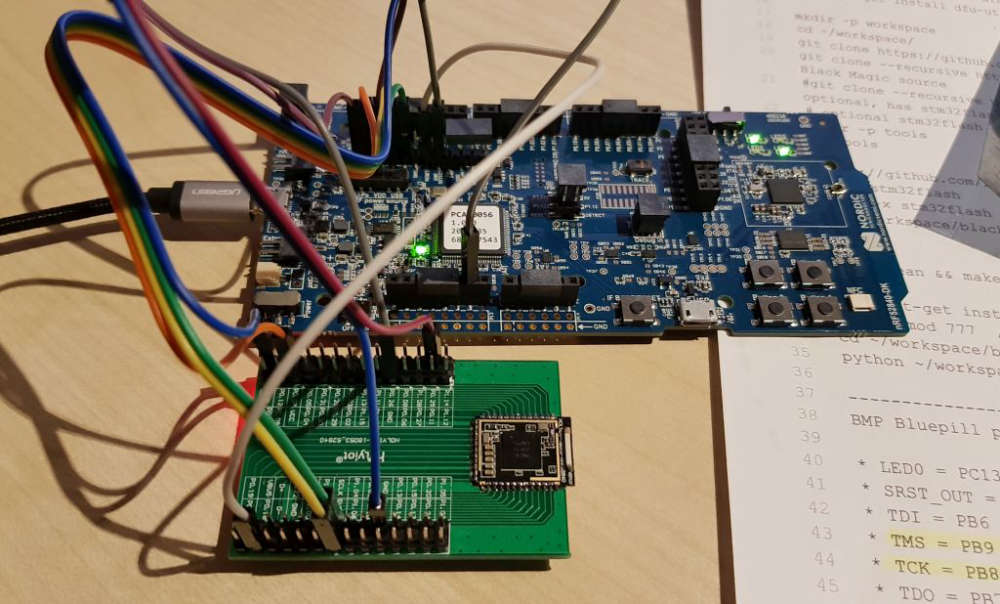
nRF52832 on BMP
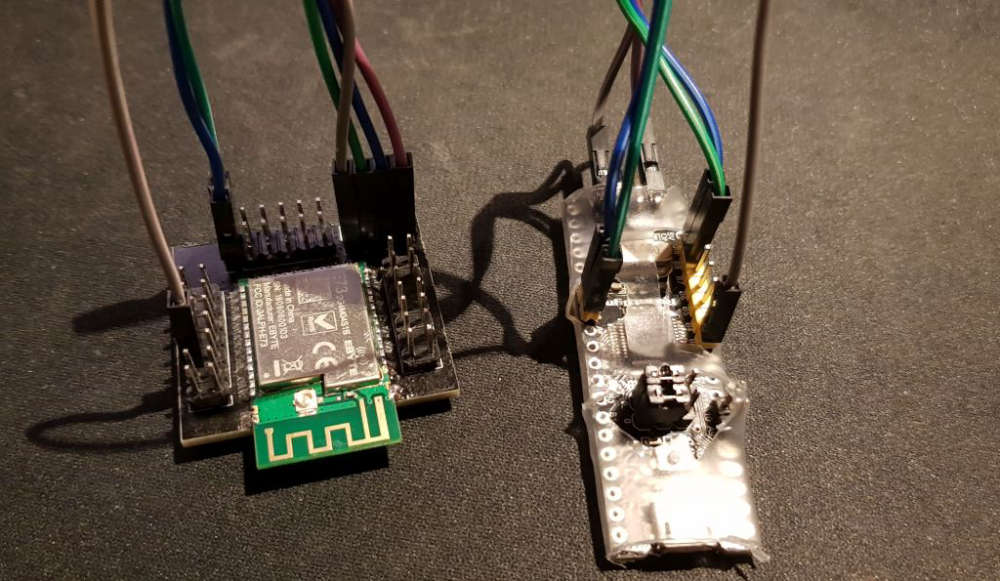
-
@NeverDie thanks, appreciate your help as you are far ahead.
Here is my update: I have build 4 nRF52832 boards with the E73 EBYTE modules and two nRF52840 board with the tiny holyiot modules (see picts below).
It seems that by using the wiring shown in my last post, I can flash the 840 boards. I'll also try again one of the working 832 boards later (I'm in business trip the next few days).
But I have a couple of questions to you:
1.) I don't know how to identify which MCU will be flashed. I only see the J-Link adapter in Segger or the board with the Segger Serial in nRFgo Studio. How can I know, that I'm not flashing the DK onboard MCU? Where is this shown, indicated where the flashing will go? That is strange to me. Another example is my sel build Black Magic Probe: It shows which devices are connected to it and you can select one (if multiple are shown in a select - select target 1,2 ...)
2.) How can I make use of any bootloader (DFU, Serial, USB, OTA, ANT etc.) so that flashing with the DK is not always required? I have not found a good way so far to flash any useful bootloader (I have tried some of the examples). The onyl one which creates a serial devices is the example for the PCA100059 (the USB dongle) which shows a serial device: nRF52 SDFU USB (COM75). HOw to make use of that (I have tried all of the offered programmer als oin Arduino IDE but could not upload/flash my blink sketch)
3.) How to you flash the USB dongle beside using the nRFconnect which requires the compiled image?
Are you also soldering the SWD pins and use them with the Segger and the DK?
4.) When I flashed your micropython (or circuitpython?) for the 840 (my board). How to I connect and use it? My 840 boards have it's own USB port (see topic 2, which shows the nRF52 SDFU port when I flash the one bootloader). When I flash the MP, the ports are gone (how to connect via USB, Serial, Terminal etc.)?I've also tried a couple of other things like a DFU bootloader with a S140 softdevice (as it was recommended by Nordic) but was not sucessful to combine them (the S140 was flashed, but then?)
I have many more questions but I hope we can sort out some of the 1-4. I hope I have described them so that you can follow my thoughts and questions :-)

nrf52840 on DK

nRF52832 on BMP

@heinzv said in Everything nRF52840:
@NeverDie thanks, appreciate your help as you are far ahead.
Here is my update: I have build 4 nRF52832 boards with the E73 EBYTE modules and two nRF52840 board with the tiny holyiot modules (see picts below).
It seems that by using the wiring shown in my last post, I can flash the 840 boards. I'll also try again one of the working 832 boards later (I'm in business trip the next few days).
But I have a couple of questions to you:
1.) I don't know how to identify which MCU will be flashed. I only see the J-Link adapter in Segger or the board with the Segger Serial in nRFgo Studio. How can I know, that I'm not flashing the DK onboard MCU? Where is this shown, indicated where the flashing will go? That is strange to me. Another example is my sel build Black Magic Probe: It shows which devices are connected to it and you can select one (if multiple are shown in a select - select target 1,2 ...)If it's wired corectly, then only the external board gets flashed.
2.) How can I make use of any bootloader (DFU, Serial, USB, OTA, ANT etc.) so that flashing with the DK is not always required? I have not found a good way so far to flash any useful bootloader (I have tried some of the examples). The onyl one which creates a serial devices is the example for the PCA100059 (the USB dongle) which shows a serial device: nRF52 SDFU USB (COM75). HOw to make use of that (I have tried all of the offered programmer als oin Arduino IDE but could not upload/flash my blink sketch)
I don't know.
3.) How to you flash the USB dongle beside using the nRFconnect which requires the compiled image?
Are you also soldering the SWD pins and use them with the Segger and the DK?Yes.
4.) When I flashed your micropython (or circuitpython?) for the 840 (my board). How to I connect and use it? My 840 boards have it's own USB port (see topic 2, which shows the nRF52 SDFU port when I flash the one bootloader). When I flash the MP, the ports are gone (how to connect via USB, Serial, Terminal etc.)?
So far I've only flashed MP to the 832 and 840 DK's. In those instances, you can do serial IO over the USB connection using putty or similar terminal.
I've also tried a couple of other things like a DFU bootloader with a S140 softdevice (as it was recommended by Nordic) but was not sucessful to combine them (the S140 was flashed, but then?)
I have many more questions but I hope we can sort out some of the 1-4. I hope I have described them so that you can follow my thoughts and questions :-)
-
Howdy y'all first off thanks @NeverDie for this thread, I spent a good time lurking at these NRF52 posts and learned and re-learned a few things here and there.
I've built an E73 NRF52832 PCB and successfully did a blink using Espruino and Adafruit's Bluefruit FW for Arduino and just noticed the $10 CAD E73-2G4M08S1C (NRF52840) back in-stock (as of October 8). I am in the process of designing a pcb board layout for it but in the meantime thought that the community might find the following useful if you plan on designing/using these modules:
-
E73-2G4M08S1C and other footprints in the same 'family' are readily available in Altium Designer format here: http://www.cdebyte.com/en/data-download.aspx?id=356&pid=202
-
Library.io allows you to convert '.pcblib' / altium files to an Eagle Library format, you just need to specify the Symbol and Package, from here you can convert to KiCad or similar I'd reckon but have not used KiCad enough to verify this. This saved me a lot of time.
In case someone was wondering: I've had no issues using the J-Link Edu Mini with the NRF52832, will update here when I get to the NRF52840.
Just starting my own NRF journey and thought to add this here in case someone is looking for E73 module specifics WRT NRF52832/NRF52840 .
-
-
Big thanks to @sandeepmistry, @lpercifield, @jeremypoulter and all others contributing to the NRF Arduino development effort. I have borrowed a lot and forked off another project for adding support for the NRF52840 dongle (PCA10059). If you are using PlatformIO and have access to a NRF52840 you can take it for a spin here PCA10059. I have tested UART, TWIM, SPIM and the BLE Led toggle example works.
-
Big thanks to @sandeepmistry, @lpercifield, @jeremypoulter and all others contributing to the NRF Arduino development effort. I have borrowed a lot and forked off another project for adding support for the NRF52840 dongle (PCA10059). If you are using PlatformIO and have access to a NRF52840 you can take it for a spin here PCA10059. I have tested UART, TWIM, SPIM and the BLE Led toggle example works.
-
@NeverDie I never liked the Arduino IDE, so I think PlatformIO is next logical step, it is very easy to get going and it opens up for advanced usage. Your own choice of editor, has great debugging capabilities with VSCode integration.
If you build the PCA10059 example I linked you should have GPIO (digital) access to all 47 pins. I've made it simple in the pca10059 variant so that D0 (0) is p0.00 -> D47 (47) is p1.15.
Some external pins on the dongle which I have tested:
Serial pins RX->P1.10, TX->P1.13
I2C, TWIM, Wire on pins CLK->P0.29, SDA->P0.31
SPI here MISO->P0.13, MOSI->P0.15, CLK->P0.17, CS->P0.22 -
@NeverDie I never liked the Arduino IDE, so I think PlatformIO is next logical step, it is very easy to get going and it opens up for advanced usage. Your own choice of editor, has great debugging capabilities with VSCode integration.
If you build the PCA10059 example I linked you should have GPIO (digital) access to all 47 pins. I've made it simple in the pca10059 variant so that D0 (0) is p0.00 -> D47 (47) is p1.15.
Some external pins on the dongle which I have tested:
Serial pins RX->P1.10, TX->P1.13
I2C, TWIM, Wire on pins CLK->P0.29, SDA->P0.31
SPI here MISO->P0.13, MOSI->P0.15, CLK->P0.17, CS->P0.22@redferne thanks for your effort spent to support nRF52840 for VS Code/Platform.io. I'll certaily give it a try. The good thing with platform.io is that it's easier to use/import existing arduino (ino) projects than in e.g. Segger Studio which only supports licensed J-Link flash/debug adapters.
Two questions:
1.) Does your "port" support also the 15.2 SDK features of the 840 (Softdevice S140, BLE 5.0 long range, ZigBee, Thread ...)
2.) What flash method is supprted/used or you're using? Just plug the USB dongle in and it can be uploaded?Oh, a third question: If I use bare nrf840 Modules, what flash adapter/mode would you recommend or have you tested (I have the 840 DK board, a ST-Link v2 and a Balc Magic Probe adapter)?
-
@nc78 Earlier you had asked about vendors for the dongle. I found an alternative dongle that ships from China:
https://www.tindie.com/products/Zelin/nrf52840-micro-dev-kit-usb-dongle/
Price is very similar. I like it better than the Nordic dongle, because it exposes pins P0.06 and P0.08, which are used by the DK for UART communications. -
@nc78 Earlier you had asked about vendors for the dongle. I found an alternative dongle that ships from China:
https://www.tindie.com/products/Zelin/nrf52840-micro-dev-kit-usb-dongle/
Price is very similar. I like it better than the Nordic dongle, because it exposes pins P0.06 and P0.08, which are used by the DK for UART communications.-
It does use the S140 v6.1.0 Softdevice, however I have only "ported"/test the most basic SDK 15.2 BLE feature of @sandeepmistry BLEPheriphal BLEPeripheral. The example shows as BLEService and Read/Writeable BLECharCharacteristic used to toggling the onboard LED. I was hoping we could get more developers involved and "port" the missing pieces, if there's interrest. My main focus was just to get something Arduino-like running using PlatformIO build system on the cheap (~$10) NRF52840 dongle.
-
I have tested Black Magic Probe (Bluepill) and JLink Mini on the PCA10059 with great success. It also possible to use the nrfutil to create a dfu.zip. The Nordic Open DFU Bootloader (which is pre-flashed on PCA10059) allows easy programming without soldering, just plug-in USB.
First get and install the nrfutil from here
- Linux environment example, first build the PCA10059 example project:
pio run -e ble- Generate a dfu.zip including the softdevice:
nrfutil pkg generate --hw-version 52 --debug-mode --sd-req 0x00 --sd-id 0xAE --application .pioenvs/ble/userfirmware.hex --softdevice ~/.platformio/packages/framework-arduinonordicnrf5/cores/nRF5/SDK/components/softdevice/s140/hex/s140_nrf52_6.1.0_softdevice.hex dfu.zip- Plugin the PCA10059 dongle in a USB port. Make sure that the Bootloader is executing by checking the RED led, should be "breathing". Else press the reset button. Now flash the new firmware, here the dongle was enumerated as ACM3.
nrfutil dfu usb-serial --package dfu.zip --port /dev/ttyACM3... and Bob's your uncle :smile_cat:
-
-
@nc78 Earlier you had asked about vendors for the dongle. I found an alternative dongle that ships from China:
https://www.tindie.com/products/Zelin/nrf52840-micro-dev-kit-usb-dongle/
Price is very similar. I like it better than the Nordic dongle, because it exposes pins P0.06 and P0.08, which are used by the DK for UART communications.@neverdie said in Everything nRF52840:
@nc78 Earlier you had asked about vendors for the dongle. I found an alternative dongle that ships from China:
https://www.tindie.com/products/Zelin/nrf52840-micro-dev-kit-usb-dongle/
Price is very similar. I like it better than the Nordic dongle, because it exposes pins P0.06 and P0.08, which are used by the DK for UART communications.Thank you for the link, it looks like an interesting dongle. But after asking for a quote at Arrows and giving up (looked like a big mess to get items shipped here as it cannot be included in another order and they would only deliver in US), I realized that they now have them in stock.
So I bought 2 at 9.5$ each + 12% discount on the website, so less than 8.5$ each and as I bought other items (including BT840 modules) I have free express shipping too. Cheapest price + free express shipping, I think it's called "having it both ways" ;) So I'll be able to join the little nrf52840 club next week. -
-
It does use the S140 v6.1.0 Softdevice, however I have only "ported"/test the most basic SDK 15.2 BLE feature of @sandeepmistry BLEPheriphal BLEPeripheral. The example shows as BLEService and Read/Writeable BLECharCharacteristic used to toggling the onboard LED. I was hoping we could get more developers involved and "port" the missing pieces, if there's interrest. My main focus was just to get something Arduino-like running using PlatformIO build system on the cheap (~$10) NRF52840 dongle.
-
I have tested Black Magic Probe (Bluepill) and JLink Mini on the PCA10059 with great success. It also possible to use the nrfutil to create a dfu.zip. The Nordic Open DFU Bootloader (which is pre-flashed on PCA10059) allows easy programming without soldering, just plug-in USB.
First get and install the nrfutil from here
- Linux environment example, first build the PCA10059 example project:
pio run -e ble- Generate a dfu.zip including the softdevice:
nrfutil pkg generate --hw-version 52 --debug-mode --sd-req 0x00 --sd-id 0xAE --application .pioenvs/ble/userfirmware.hex --softdevice ~/.platformio/packages/framework-arduinonordicnrf5/cores/nRF5/SDK/components/softdevice/s140/hex/s140_nrf52_6.1.0_softdevice.hex dfu.zip- Plugin the PCA10059 dongle in a USB port. Make sure that the Bootloader is executing by checking the RED led, should be "breathing". Else press the reset button. Now flash the new firmware, here the dongle was enumerated as ACM3.
nrfutil dfu usb-serial --package dfu.zip --port /dev/ttyACM3... and Bob's your uncle :smile_cat:
@redferne wow and thanks again for your fast and complte/detailed answer.
I like especially- that you already started to use/support softdevices S140 and thus BLE 5.0, thread and Zigbee is "potentially" available
- that you also succesfully use Black Magic Probe, as I also wante to use it because it works in Arduino IDE and Platform.io and it supports also an UART Port to communicate (I also use Blue/Blackpill BMP's)
It would be great if it would be posssible (if not already) to use BLE 5.0 with the long range feature (that is not supported by the older S132 or nRF52832). Zigbee would be also great. But not sure what of the features (for a reliable longer indoor range) would be usable from within the MySensors project (beside using the nRF52 as/with the nRF24 proticol).
-
-
One interesting thing I stumbled upon:
https://github.com/insane-adding-machines/unicore-mx
UniCore-MX | Universal Core for ARM Cortex-M0/0+/3/4/7/X
Supports nRF51/52
-
One interesting thing I stumbled upon:
https://github.com/insane-adding-machines/unicore-mx
UniCore-MX | Universal Core for ARM Cortex-M0/0+/3/4/7/X
Supports nRF51/52
This post is deleted! -
One interesting thing I stumbled upon:
https://github.com/insane-adding-machines/unicore-mx
UniCore-MX | Universal Core for ARM Cortex-M0/0+/3/4/7/X
Supports nRF51/52
@uhrheber said in Everything nRF52840:
One interesting thing I stumbled upon:
https://github.com/insane-adding-machines/unicore-mx
UniCore-MX | Universal Core for ARM Cortex-M0/0+/3/4/7/X
Supports nRF51/52
I looked at the link, but I can't figure out what problem it's solving. What's the headline on that?
-
-
It does use the S140 v6.1.0 Softdevice, however I have only "ported"/test the most basic SDK 15.2 BLE feature of @sandeepmistry BLEPheriphal BLEPeripheral. The example shows as BLEService and Read/Writeable BLECharCharacteristic used to toggling the onboard LED. I was hoping we could get more developers involved and "port" the missing pieces, if there's interrest. My main focus was just to get something Arduino-like running using PlatformIO build system on the cheap (~$10) NRF52840 dongle.
-
I have tested Black Magic Probe (Bluepill) and JLink Mini on the PCA10059 with great success. It also possible to use the nrfutil to create a dfu.zip. The Nordic Open DFU Bootloader (which is pre-flashed on PCA10059) allows easy programming without soldering, just plug-in USB.
First get and install the nrfutil from here
- Linux environment example, first build the PCA10059 example project:
pio run -e ble- Generate a dfu.zip including the softdevice:
nrfutil pkg generate --hw-version 52 --debug-mode --sd-req 0x00 --sd-id 0xAE --application .pioenvs/ble/userfirmware.hex --softdevice ~/.platformio/packages/framework-arduinonordicnrf5/cores/nRF5/SDK/components/softdevice/s140/hex/s140_nrf52_6.1.0_softdevice.hex dfu.zip- Plugin the PCA10059 dongle in a USB port. Make sure that the Bootloader is executing by checking the RED led, should be "breathing". Else press the reset button. Now flash the new firmware, here the dongle was enumerated as ACM3.
nrfutil dfu usb-serial --package dfu.zip --port /dev/ttyACM3... and Bob's your uncle :smile_cat:
@redferne I was trying to get your platform and board extention as wellas the BLE library added to platformio, but got stuck afetr many many hours and many attempts (too much to add all the problems in one post). I'm using platformio with Windows 10 (I guess you use it with Linux/Ubuntu and also with a couple of command line tools)
I was trying to install this two:
https://github.com/Redferne/arduino-nRF5
Redferne/arduino-BLEPeripheralI was trying to build a couple of simple examples and also the
C:\users\internet.platformio\lib\BLEPeripheral\src\BLEBondStore.cpp:11:12: fatal error: nrf_soc.h: No such file or directory
and
C:\users\internet.platformio\lib\BLEPeripheral\src/BLEPeripheral.h:136:5: error: 'nRF52840' does not name a type; did you mean 'NRF52840'?and all other following errors are probably the result of the above ones.
Any hints?
Another question: How to define/declare the usage of the S140 softdevice in the project?
Using the PlatformIO IDE, not the command line. -
-
As pointed out by @reinhold, here's a handy tool for programming your nRF52840 dongle, and possibly other nRF52 projects too:
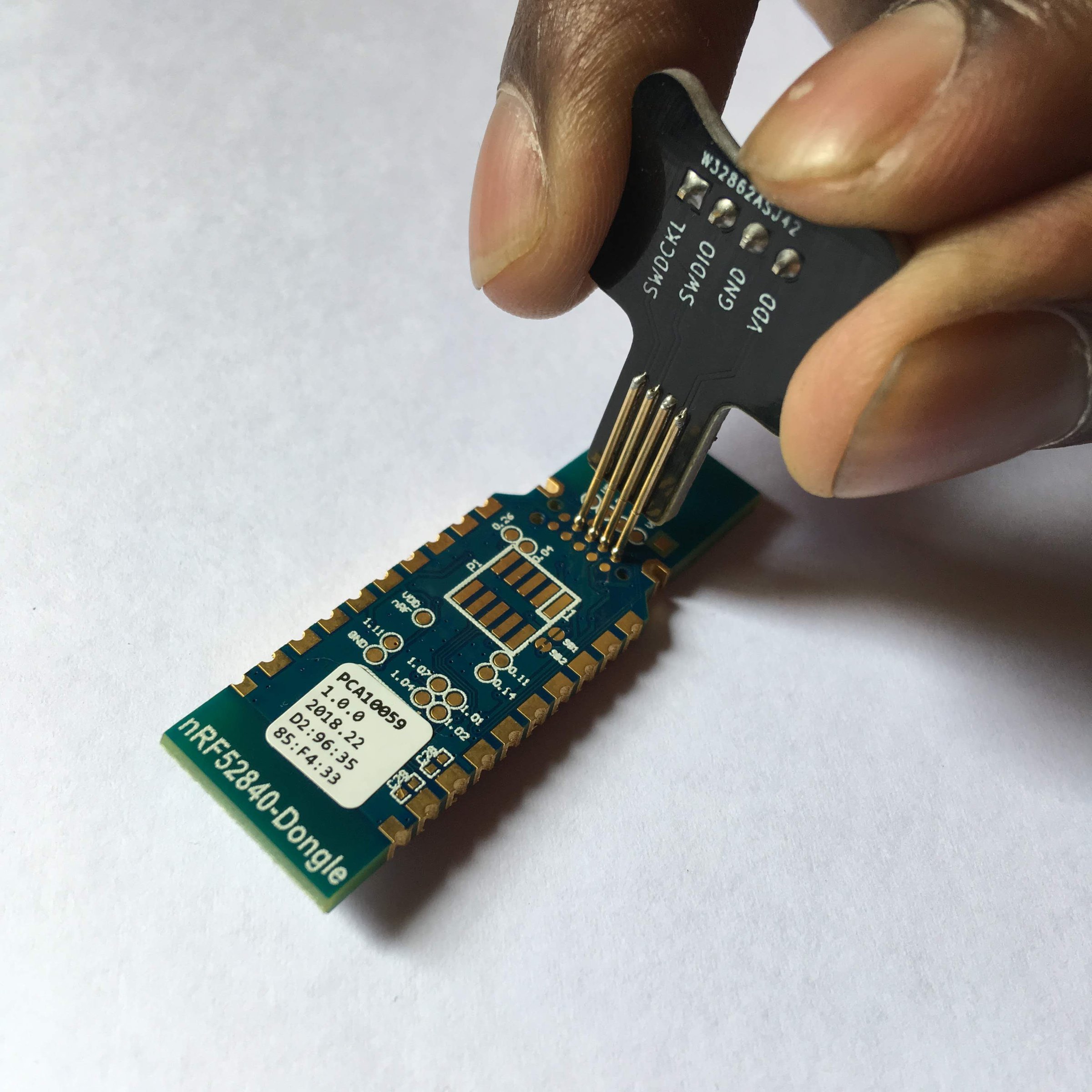
https://www.tindie.com/products/ElectronutLabs/pogoprog-model-c-pogo-pin-programmer-swd-2-pack/I think I'd like it better if it could somehow latch itself to the board, though, so that I could also get debugging information hands free without having to continually press the tool up against the board.
-
@redferne I was trying to get your platform and board extention as wellas the BLE library added to platformio, but got stuck afetr many many hours and many attempts (too much to add all the problems in one post). I'm using platformio with Windows 10 (I guess you use it with Linux/Ubuntu and also with a couple of command line tools)
I was trying to install this two:
https://github.com/Redferne/arduino-nRF5
Redferne/arduino-BLEPeripheralI was trying to build a couple of simple examples and also the
C:\users\internet.platformio\lib\BLEPeripheral\src\BLEBondStore.cpp:11:12: fatal error: nrf_soc.h: No such file or directory
and
C:\users\internet.platformio\lib\BLEPeripheral\src/BLEPeripheral.h:136:5: error: 'nRF52840' does not name a type; did you mean 'NRF52840'?and all other following errors are probably the result of the above ones.
Any hints?
Another question: How to define/declare the usage of the S140 softdevice in the project?
Using the PlatformIO IDE, not the command line.@heinzv I'm sorry if I was unclear. I have only updated and tested one example which is the PCA10059 It should build without errors, but you might need to specify build type as "ble" or "dongle" as per the readme.
To enable the NRF52840 support use these flags:
-DNRF52 -DNRF52840 -DNRF52840_XXAAand if building with the BLE Peripheral library and Softdevice S140 add:
-DNRF52 -DNRF52840 -DNRF52840_XXAA -DNRF52_S140

